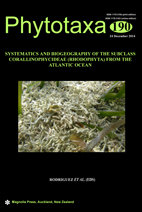Abstract
New specimens of Paulsilvella huveorum were collected in Brazil at Baía de Ilha Grande, Rio de Janeiro, and Sebastião Gomes reef, Bahia. This new collections represent a relevant range extension and new hosts for the species (Amphiroa beauvoisii, Jania cubensis and non-identified Hydrozoa and Bryozoa) and enabled the first DNA amplifications for Paulsilvella. The systematic position of Pausilvella in the subfamily Lithophylloideae is confirmed based on SSU rDNA, psbA and rbcL molecular markers. Morphologically and anatomically the specimens are similar to the original description in where basal dimerous thalli with monomeric erect branches characterize the genus. But, the analyzed carposporangial conceptacles express the roof position varying from flush or above the thallus surface, the chambers always buried within tiers of columnar cells, suggesting that this feature is variable within the species and might also suggest that P. huveorum and the fossil P. antiqua should be considered as potential synonyms. We do not want to suggest this clump waiting for more collections from different geographical areas in where new data may support our idea. Our results strongly suggest that the subfamily Lithophylloideae urgently needs to be reviewed to delimit genera based on molecular and morphological analysis because monomeric and dimeric thalli organization have evolved several times in the group.

